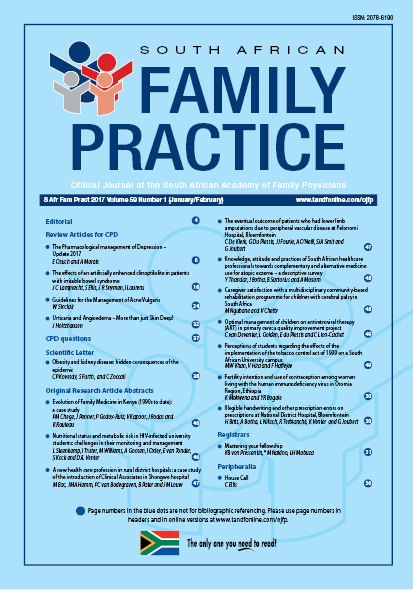The eventual outcome of patients who had lower limb amputations due to peripheral vascular disease at Pelonomi Hospital, Bloemfontein
Keywords:
Bloemfontein, lower limb amputations, patient outcome, peripheral vascular disease
Abstract
Background: Peripheral vascular disease (PVD) presenting with irreversible lower limb pathology has a high morbidity and mortality rate. This study aimed to determine the outcome of patients who underwent lower limb amputations (LLAs) because of PVD at Pelonomi Hospital, Bloemfontein, 2008–2011. Methods: Prospective data collection of a retrospective cohort study group was performed. Included were patients with PVDinduced LLAs. Demographic and contact information was collected from Meditech. Living status (alive or dead) was determined using the Department of Home Affairs database and interviews with relatives. Results: Of the study population (n = 224), 119 had contact information. Data of 158 people were available to determine living status: 71.5% had died by follow-up in 2014. Forty-nine interviews were possible, 31 patients had died, with cause of death reported to be primarily vascular related. The cumulative mortality showed that 16.1% died within a month and 48.4% within one year post-amputation. Among the 18 living amputees, 50.0% became unemployed, 77.8% used wheelchairs, 11.1% used crutches and 11.1% a prosthesis. Conclusion: Lower limb amputation due to PVD is indicative of a poor prognosis. In our study only 28.5% of patients survived 3–6 years post-amputation. Restoration to ideal mobility was achieved in a minority of cases. (Full text of the research articles are available online at www.medpharm.tandfonline.com/ojfp) S Afr Fam Pract 2017; DOI: 10.1080/20786190.2016.12481450
Section
Original Research
By submitting manuscripts to SAFP, authors of original articles are assigning copyright to the South African Academy of Family Physicians. Copyright of review articles are assigned to the Publisher, Medpharm Publications (Pty) Ltd, unless otherwise specified. Authors may use their own work after publication without written permission, provided they acknowledge the original source. Individuals and academic institutions may freely copy and distribute articles published in SAFP for educational and research purposes without obtaining permission.

